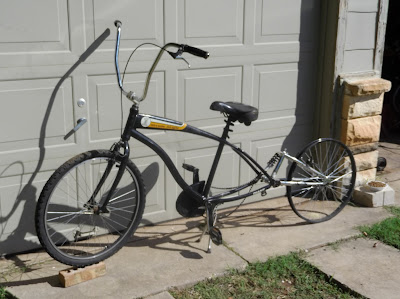Answering Bob's Electric Motorcycle and Silver Pigeon Questions
Normally, I like to write about odd and unexpected vehicles, but today I'm writing about a rare and unexpected occurrence - a reader not only used the comment feature but also asked a couple of questions. This is exciting stuff!
The Pigeon Projects (Where I Talk too Much)
My e-Vespa
Years ago, I converted a vintage Vespa scooter to run on batteries. I replaced the original running gear with a rear hub motor and replaced the fuel system with a 48 volt battery pack. And it was mostly a success. But I made one minor miscalculation - I ended up with a scooter that would run only 28 miles per hour. And Lubbock is pretty much a 40 mph town. Even on residential streets, West Texans have little use for dorks inconsiderate enough to run less than 35. The Vespa has been ridden very little, but no one has run it over!
I learned then that the biggest drawback to using a hub motor is that the only practical way to add speed is to add more voltage. But I had already spent a lot of money on the 48-volt battery pack and had figured out that my battery was physically too big to fit in the Vespa body anyway.
Isn't she beautiful?
So, I started looking forward to my next scooter conversion. I wanted something with Italian styling but plenty of room for big batteries. It also needed to be cheap and sturdy. That sent me on a quest for a Montgomery Wards/Mitsubishi Silver Pigeon (which took its styling from the Italian Lambretta LD - one of my all-time favorites). And one day my friend Spencer showed up with a pair of Pigeons.
The project was off and running!
What she looks like now
The EVT 168 DonorCycle
(When I do get back to the Pigeons, I hope to build them with at least 2000 watt hub motors powered by 72 volt - 20 amp-hour battery packs.)
Battery Pack for a golf-cart motored cycle (where bob meets Ben)
The good news in using a golf cart motor (instead of a hub motor) is that you have a lot more flexibility in your battery needs. You have the variable of changing your gearing.
The best approach is to go backwards - figure out what you want to accomplish, and base your needs around that. First, you need to answer three questions:
- How fast do you want to go?
- How far do you want to go?
- How much can you spend?
If you don't answer those questions first, there's a good chance you'll end up with a disappointing result that never gets ridden. If your answers to one and two are large numbers, the answer to number three will need to be a very large number.
Most older golf carts run on 36 or 48 volts. If you're using the stock controller, you are tied to the controller's voltage, but that's not a terrible thing. The setup should have more than enough torque for a motor bike. The trick will be to come up with the right gear ratio to achieve the speed speed you want.
Since I've not built a golf-cart motored motor bike, I am going to refer you to Ben Nelson, a guy who has a lot of experience building electric vehicles with repurposed motors. Video 1 will be Ben interviewing a guy who built a motorcycle with a golf cart motor. Video 2 will be the first video of several that explain how to convert an old motorcycle to electric.
There you have it, Bob. Thanks for the questions, and please keep me posted with your motor bike project.
May we all find answers to our low-carbon project questions!
PS. If you're in this part of Texas, another unfinished project I have around is a Suzuki motorcycle rolling frame with a golf-cart motor already mounted in it. I bought it in this condition and don't see myself ever finishing it. I'd sell it cheap to someone who'd like to tackle it.









Comments
Post a Comment